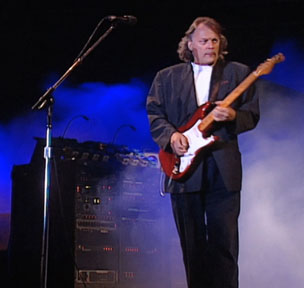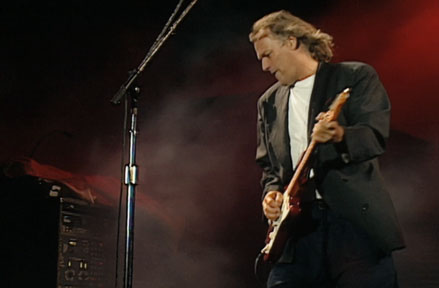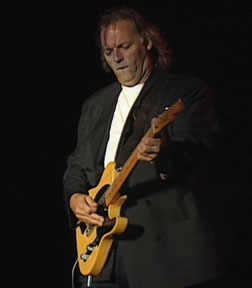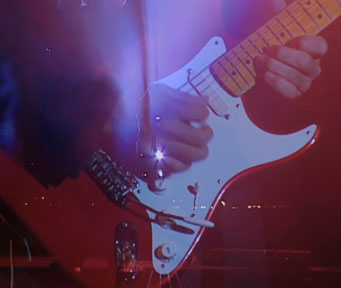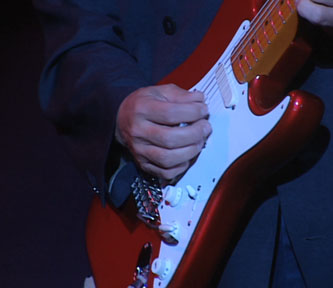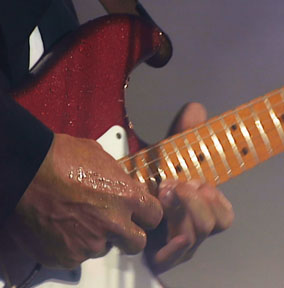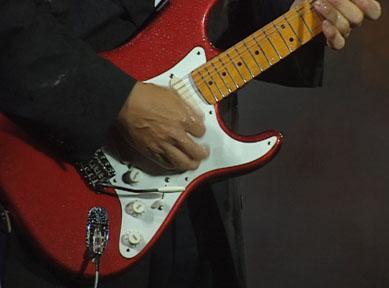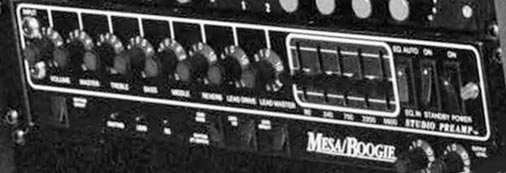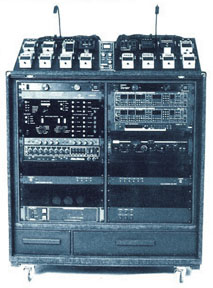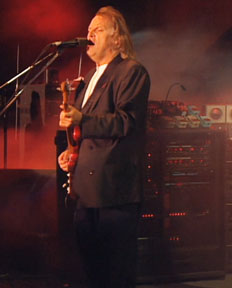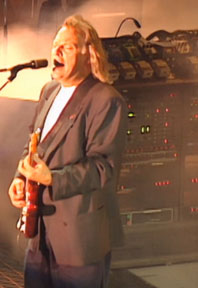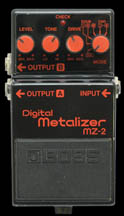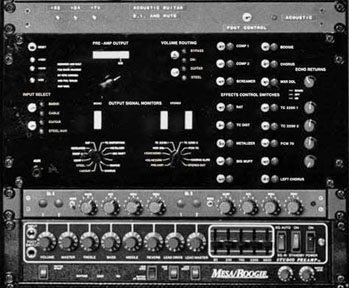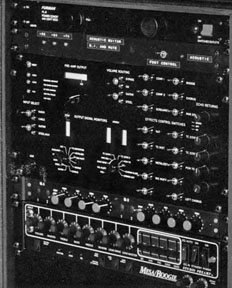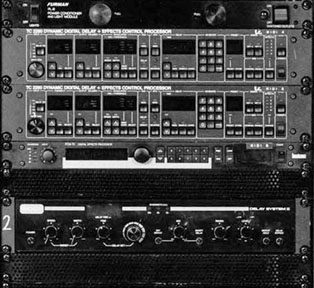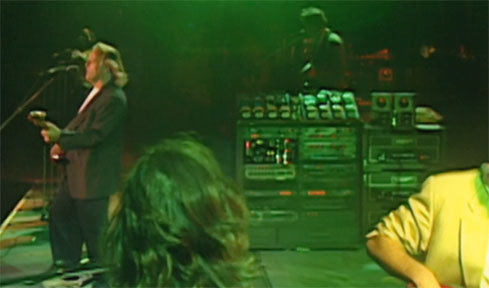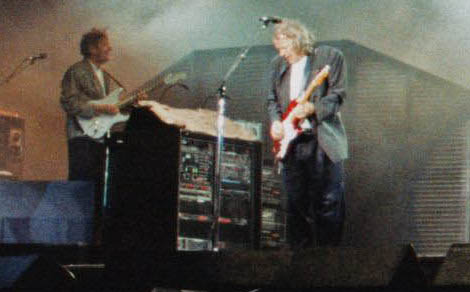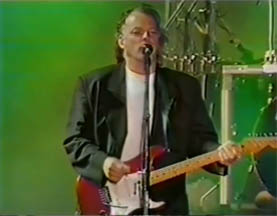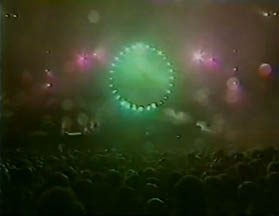NOTE: This website is frequently updated. Last update March 2024.
Gilmour's Cornish modified guitar effects rig, amplifiers, and shoulder pads used in 1990
Pete (Cornish) stabilised and altered the power supply for the Bradshaw foot controller board which, minus its audio side, was retained when the system was completely rebuilt for the 'Division Bell' tour. We essentially married the board to a Pete Cornish audio routing system. - Phil Taylor, March 1997 Sound On Stage
1990 - THE KNEBWORTH FESTIVAL CONCERT RIG - Bob Bradshaw/CAE assembled the original version of this pedal board, rack effects, and switching system for the Momentary Lapse of Reason tour. The system had problems during that tour however, resulting in one show being stopped when the system broke down. Around March 1990 effects rig guru Pete Cornish was brought in to rebuild sections of the rig, add new effects, and install a new switching system prior to the one-off performance by Pink Floyd at the Knebworth Festival in June 1990. This version of the rig can be heard and seen in recordings of the televised Knebworth Park Festival performance by Pink Floyd in June 1990, officially released in 2019 on CD and Blu Ray in Pink Floyd's The Later Years boxed set. Below is a selection of Gilmour solos from that concert.
![]() Solos from Kenbworth Festival 1990
Solos from Kenbworth Festival 1990
David playing the intro to Shine on You Crazy Diamond with his 57V Fender Strat with EMG-SA pickups
David playing Comfortably Numb in the rain at Knebworth Park
The rack effects were changed, including a new Pete Cornish switching system with built in buffers. An Alembic F2-B preamp was added as the master preamp for the rig in place of the Custom Hiwatt AP100 preamps. The F2-B was a bass preamp, similar to the preamp used in the Fender Showman/Fender Twin Reverb. Using the F2-B preamp for the whole rig was something unique to both the 1990 and 1994 Pink Floyd rigs, but it was never used this way after that. David had been using an F2-B in front of his Yamaha RA-200 rotating speaker cabinets since the late 1970s, but in 1990 he decided to try it in place of his Hiwatt preamps. According to Pete, David decided he no longer liked the EQ of the Hiwatt tone stack and prefered the F2-B. In essence, Pete merged the Fender tone stack with a Hiwatt power amp, but with some modifications to make it work better in this rig and with the closed back speaker cabinets being used. David wanted to boost the mid range above the maximum stock range, more like the Hiwatt tone stack, and cut the bass below the minimum stock range. Pete was asked to make the following modifications to the F2-B in 1990:
• change the Bright switch to an upper mid range boost - Note, David did not use this mod
• change the mid range control to allow more mids boost at the top end of the pot sweep - similar to the Hiwatt mid range response
• change the bass capacitor to reduce some of the low frequencies when the bass pot was set to minimum -
...This was because the sound of the Celestion speakers was too boomy through the closed back Marshall speaker cabinets
• move the inputs from the front of the Alembic to the back back in order to better facilitate its use in the rack system
• Bring the F2-B up to current signal voltage and impedance standards, which included adding a master volume control for each channel on the back to lower the output, and adding a ground lift transformer and tube buffer to lower the impedance on the outputsNote that Phil Taylor, David's backline tech, stated in a 1994 interview that an extra preamp tube was added to give the Alembic a slight amount of drive, and this was quoted in several guitar magazines. That seems to be innacurate, according to Pete Cornish. Possibly Phil misunderstood the output tube buffer mod that Pete added.
The F2-B was placed in the effects rack near the end of the signal chain. Since it was used as the master preamp for the whole rig, the three DR103 Hiwatts from the 1988-89 tour were modified by Pete Cornish to add insertion points to bypass the preamps, so only the Hiwatt power amps were used. This allowed a Fender/Hiwatt blend.
The modified Alembic F2-B preamp with hole covers in place of the front input jacks, which were moved to the back of the unit. The preamps in the three Hiwatt DR103 power amplifiers were bypassed in order to use the F2-B as the master preamp for the rig.
A Cornish P-Fuzz (Precision Fuzz, later re-named the P-2) remained the primary distortion pedal for the high gain lead tones. The P-Fuzz in this rig appeared to be a later version than the one used in the 1989 rig. It was housed in an all-black enclosure with a Pete cornish ID label on front end, rather than the gray hammerite enclosure the previous P-Fuzz was housed in. A Rat and extra Boss GE-7 were added to the pedal board. The two Mesa/Boogie amp heads used as overdrives from the 1989 leg of the tour were removed and replaced with a rack mounted 1989 Mesa/Boogie Studio Preamp. In the July 1995 issue of guitarist magazine Pete Cornish described the Boogie's use as "in effect, a preamp." However, the effect signal chains show it was actually used as an overdrive and to blend with the Boss MZ-2 Digital Metalizer and Cornish P-Fuzz, as on the previous tour. The rhythm channel overdrive from the Studio Pre sounds very similar to the Mesa/Boogie Mark III. It was also much easier to incorporate into the signal chain than the Mark III rack head since it required no dummy load on the speaker output.
David Gilmour's rack mounted Mesa/Boogie 2 channel Studio Preamp. The Studio Pre was used as an overdrive and to blend with the MZ-2 and P-2. These photos were shot by Pete Cornish in his shop after completing modifications to the rig, so the settings may not be accurate to what David actually used on the 1989 leg of the tour, but I believe they are close. The lead drive and master knobs are set to 0 and the rhythm channel is set to the on positionon position, so I think the rhythm channel was used when combining with the P-2.
I am a big fan of the Mesa/Boogie Studio Preamp. The design and layout are similar to the Mesa/Boogie Mark III, using circuitry similar to the Mesa/Boogie Mark IIC+. It was marketed as a less expensive version of Mesa's Quad Studio Preamp. The Quad was two separate preamps in one box - one identical to the 2 channel Studio Preamp, which is a Mark IIC circuit, and the other based on the original 2 channel Mark III circuit. Obviously the power amp stage of the mark II/III is missing from the Studio, but David was really only using the Boogie for the overdrive from its preamp stage. The fact that David used the single Studio Pre instead of the Quad version is another indication that he ONLY used the Boogie for its rhythm preamp channel, not the lead channel. It has same cascading gain stage design and tone versatility, as well as Mesa's trademark 5 band graphic equalizer.
The clean tone from the rhythm channel is pure Fender tone - very much like a Fender Blackface or early Silverface circuit. Like the Alembic F2-B, the Studio Preamp clean channel circuit is basically the same as the Fender Twin Reverb, minus the tube output stage. I would go as far to say that when the Studio is used as a preamp it matches the Alembic F2-B preamp sound, but with far more versatility. But of course the F2-B was actually used as a preamp, where the Studio was used as an overdrive effect in the signal chain in this rig. Some light overdrive can be dialed in using the rhythm channel, nearly replicating the same sound David got with the Mark III rack head when using the MAIN signal output (not the Recording outs) on the back of the Studio. It really adds a lot to the tone when blending with an EHX Big Muff, Boss HM-2, or Cornish P-2. The 5 band EQ is where the tone of those pedals can be accurately sculpted into Gilmour's high gain lead tones heard from 1988 - 1990.
Gilmour's guitar effects rig and amplifiers used in 1990
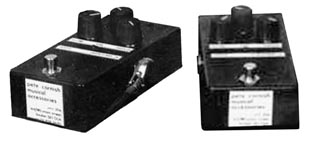
The Pete Cornish P-Fuzz, a custom mde Big Muff with a brighter mid range than most of the Electro-Harmonix originals. This version of the P-Fuzz was housed in a black enclosure with a Cornish ID label on the front end, rather than the gray hammerite enclosure of the P-Fuzz in the 1988-89 rig. In the late 2000s it was sold to the public in a larger gray enclosure with a built in buffer stange. It was re-named the P-2 Fuzz, then simplified to just P-2.
The Boss MZ-2 Digital Metalizer was used as an overdrive and blended with the Mesa/Boogie Studio Preamp for Money
David Gilmour's 1990 pedalboard after Pete Cornish modifications (left side top row) two Boss CS-2 compressors, Ibanez TS10 Tube Screamer, ProCo Rat
(left side bottom row) four boss GE-7 equalizers (one for each effect above)
(right side top row) TC Electronic BLD (Booster + Line Driver & Distortion), Boss MZ-2 Digital Metalizer, Pete Cornish P-Fuzz (modified Big Muff), Boss CE-2 chorus (left)
(right side bottom row) three Boss GE-7 equalizers (one for each effect above), Boss CE-2 chorus
(shown above left and midle) David Gilmour's 1990 effects rack - left side
Pete Cornish custom built effects router with each effect-on LED labeled
Alembic F2-B preamp with Pete Cornish modifications
Mesa/Boogie Studio Preamp
(shown above right) David Gilmour's 1990 effects rack - right side
Furman Power Conditioner
TC2290 Digital Delay
TC2290 Digital Delay
MXR Digital Delay System II
Lexicon PCM70 Digital Effects Processor
Gilmour's guitar effects rig and amplifiers used at Knebworth
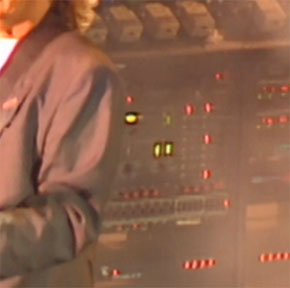
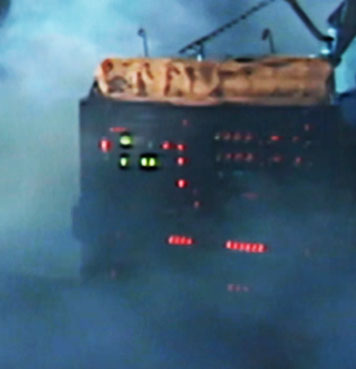
Gilmour's effects router used at Knebworth
1990 SONG-BY-SONG SIGNAL CHAINS - David's effect router LEDs are visible for each song in the video so it was possible to match those up with the effects labeled in the router photos to determine the exact signal chains for each song. The concert was short, so most of the effects were never used.
Shine On You Crazy Diamond
Isolated Guitar Solos - Knebworth 1989
....Intro Solo – Comp 1 (Boss CS-2) > Mesa/Boogie Studio Preamp > TC 2290 Digital Delay 1 > Boss CE-2 chorus (left)
....Outro Delay Pattern – Comp 2 (Boss CS-2) > CE-2 chorus > TC2290 Delay > Boss CE-2 chorus (left)Great Gig In the Sky
Isolated Guitar and Piano - Knebworth 1989
....Slide Guitar – Comp 2 (Boss CS-2) > TC 2290 Digital Delay > CE-2 chorus (left) .Sorrow
Isolated Guitar Intro - Knebworth 1989
Isolated Guitar Solos - Knebworth 1989
....Intro/Outro – Cornish P-2 > Mesa/Boogie Studio Preamp > TC 2290 Digital Delay 1 > CE-2 chorus (left)
.......I think David is switching on the Mesa/Boogie EQ stage with a foot switch for the intro/outro
....Solos – Cornish P-2 > Mesa/Boogie Studio Preamp > TC 2290 Digital Delay 1 > CE-2 chorus (left) .Money
Isolated Guitar Solos - Knebworth 1989
....Intro Riff – Comp 1 (Boss CS-2) > MZ-2 Metalizer > Mesa/Boogie Studio Preamp > Boss CE-2 chorus (left)
....First Solo – Cornish P-2 > Mesa/Boogie Studio Preamp > TC 2290 Digital Delay 1 > CE-2 chorus (left)
....Dry Solo – Cornish P-2 > Mesa/Boogie Studio Preamp > CE-2 chorus (left)Comfortably Numb
Isolated Guitar solos - Knebworth 1989
....Intro and Solos – Cornish P-2 > Mesa/Boogie Studio Preamp > TC 2290 Digital Delay 1 > CE-2 chorus (left)
.....David kicks on a second delay for the unison bend part of the solo, but I cannnot tell which oneRun Like Hell
Isolated Guitar - Knebworth 1989
....Comp 2 (Boss CS-2) > CE-2 chorus > TC 2290 Digital Delay 1 > CE-2 chorus (left)
....
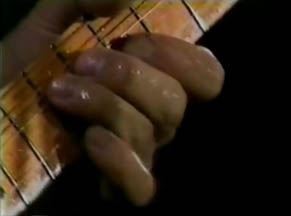
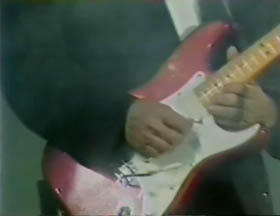
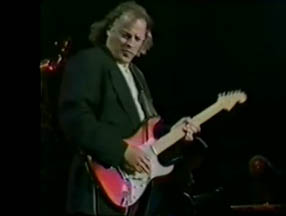
* Thanks and More Thanks to: Dustin Tiemeier and Carl Fuehrer who authored the old David Gilmour Home Page (now defunct), the first place I read about this rig on the internet, way back in 1998, and one of the first Gilmour resources on the web. Thanks to John Roscoe and Bob Bradshaw for help, notes, and photos of the 1987-88 rig and signal chain, and Pete Cornish of course.
Kit’s Secret Guitar, Gear, and Music Page
Guitar stuff, gear stuff, soundclips, videos, Gilmour/Pink Floyd stuff, photos and other goodies.
Copyright Kit Rae.
VISIT MY SWORDS, KNIVES and FANTASY ART WEBSITE www.kitrae.net

